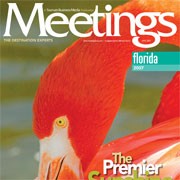From sea to shining sea, Florida is a land of contrasts—geographical, cultural, recreational. Here on this subtropical peninsula, where the sun rises over the Atlantic Ocean and sets over the Gulf of Mexico, crystal springs bubble up from a lush interior of lakes and forests, while vast swamps and marshlands meet saltwater beaches that have been drawing crowds of people since the days of Ponce de Leon.
Within this landscape of palms and magnolias, stately Old South mansions and trend-setting high-rise lofts, theme parks and wilderness parks, Florida also has been evolving past its longtime identity as the country’s sun-and-fun playground into a no-nonsense meetings destination with a strong business background.
Consider the resources. In Orlando, right next to some of the world’s most popular attractions stands the country’s second-largest convention facility, the Orange County Convention Center. On every beach lining the coast from Jacksonville around to Pensacola, there are convention hotels and waterfront conference venues rising beside the palm trees. Minutes from the cruise ports that launch ships to every part of the globe there are international and regional airports welcoming every legacy and low-cost carrier in existence.
And then there are the people. From local citizens to the CVBs to the state level, Floridians are hard-wired to welcome visitors.
“Tourism is our No. 1 industry,” says Tracy Vaughan, director of sales for Visit Florida, the state’s official source for travel planning. “People who come to Florida want to know there are experienced people taking care of things, and we have that ability, whether our clients are here for leisure or business.”
In particular, serving that latter category has become a statewide priority, according to Vaughan.
“We literally have the entire state going after this market segment now. We’re seeing it across the board, and I think that’s unique. In other states, meetings are concentrated in the big cities. We have that, too, but we’re also going after the smaller events,” she says, pointing to destinations like Daytona, Fort Myers and Sandestin, which complement such convention powerhouse cities as Orlando, Miami/Fort Lauderdale and Tampa.
Another small-group segment that’s growing by the minute is incentive business, thanks to an uptick in luxury properties statewide and an increase in luxury amenities among existing hotels and resorts.
“I think we’re definitely stepping up our incentive business,” Vaughan says. “We can attract a variety of meetings big and small, all year-round. I don’t think there’s anybody else that can really put that out there.”
Maintaining and increasing the state’s share of group business also has become a top priority at Visit Florida, where a one-stop-shop website, www.meetings.visitflorida.com, is being launched this spring, and a greater share of the annual budget has gone into researching the meetings market. Additionally, Visit Florida will debut its revamped meeting planner’s guide this August as a printed complement to the electronic planning site, while the state’s complimentary Cover-Your-Event (CYE) supplemental insurance, which covers the costs related to rebooking a meeting displaced by a named hurricane, has been extended through 2008.
Meanwhile, of the 84.6 million people who visited Florida in 2006—a slight increase over 2005—Visit Florida is hoping the figures for meetings and conventions maintain the same upward momentum as the statewide commitment to facilitating group business.
“It’s very important to all our communities that we keep people coming back,” Vaughan says. “Yes, we have the sun, the facilities, the beaches, and so forth. But I think what meeting planners are in touch with today are service levels. And we have that here in Florida.”






